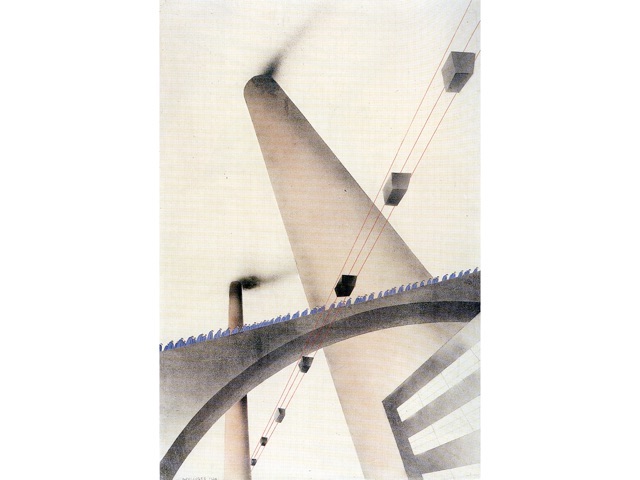

Excluded and yet entangled in two dictatorships:
The political constructivist Oskar Nerlinger
Eckhart Gillen, Berlin
February 10, 2021 @ 12:00 pm - 1:00 pm
| FreeOskar Nerlinger (1893-1969) was one of the most important artists of the committed art scene in the Weimar Republic. He was a member of the Association of Proletarian Revolutionary Art (ASSO for short), which was founded in 1928 and belonged to the KPD, which cooperated with the Soviet avant-garde artist group Oktober. At that time there was no conflict between positions of aesthetic modernism and KPD politics. In 1932 the political and artistic avant-garde in the Soviet Union fell apart, with serious consequences for left-wing artists in Germany. Almost at the same time, the Nazi system broke with all forms of modernity. With his idea of art suddenly doubly isolated within his own party, which followed Stalin’s art verdict, and within Germany through the Nazi art policy, Nerlinger went into so-called “inner emigration”, but behaved in a very contradictory manner and adapted his artistic language to the Nazi aesthetics. After 1945 he joined the SED and followed the given political norms of socialist realism as part of the formalism campaign.
The twofold turning point in 1932 and 1933 left lasting traces in Oskar Nerlinger’s art. With this transition from innovation to regression, Nerlinger stands for a whole generation of politically committed artists in the Weimar Republic who, blindly believing in the doctrines of the communist party, gave up their own aesthetic and moral convictions. In a paradoxical way, Nerlinger was marginalized and at the same time entangled in two dictatorships.
Lecture by
Eckhart Gillen, PhD, Independent Curator in Berlin (Germany)
Introduced by
Rachel Stern, Executive Director of the Fritz Ascher Society in New York
Eckhart Gillen, Art Historian, Independent Curator, based in Berlin. Study of art history, German and Sociology at the University of Heidelberg, where he received the Doctorate from the Faculty of Philosophy. He has organized numerous exhibitions and published widely on Russian, American, and German art of thetwentieth century. Among his exhibition catalogs and books are „Amerika –Traum und Depression 1920/40“, Akademie der Künste, Berlin 1980; „German Art from Beckmann to Richter: Images of a Divided Country“; Yale University Press 1997; „Art of Two Germanys/Cold War Cultures 1945-1989“, LACMA, L.A., Germanisches Nationalmuseum Nuremberg, Deutsches Historisches Museum Berlin 2009 (in collaboration with Stephanie Barron); „Feindliche Brüder? Der Kalte Krieg und die deutsche Kunst 1945-1989“, Berlin 2009; R.B.Kitaj – The Retrospective, 2012, Jewish Museum Berlin, Jewish Museum London and Hamburger Kunsthalle; Art in Europe 1945-1968: Facing the Future, BOZAR, Brussels, ZKM, Karlsruhe, Pushkin Museum, Moscow, 2016/17; „FLASHES OF THE FUTURE. The Art of the 68ers“, Ludwig Forum, Aachen, 2018; „Constructing the World. Art and Economy 1919 to 1939 in USA, Soviet Union and Germany“ in the Kunsthalle Mannheim, 2018/19.
Numerous distinctions, including „einheitspreis – Bürgerpreis zur deutschen Einheit“ 2003 (bestowed by the Federal Agency for Civic Education), AICA-USA 2009 for Best Thematic Museum Show, and the Friedlieb Ferdinand Runge Award 2011 conferred by the foundation Preußische Seehandlung for unconventional art communication (together with Stefanie Barron). Adjunct professor for art history at the Film University in Potsdam-Babelsberg since 2011.
The event is part of our monthly series
Flight or Fight. stories of artists under repression, which is generously sponsored by Allianz Partners.
Ausgegrenzt und doch verstrickt in zwei Diktaturen: Der politische Konstruktivist Oskar Nerlinger (1893-1969)
Eckhart Gillen, Berlin
Oskar Nerlinger (1893-1969) gehörte zu den wichtigsten Künstlern der engagierten Kunstszene in der Weimarer Republik. Er war Mitglied der 1928 gegründeten Assoziation der proletarisch revolutionären Kunst (abgekürzt ASSO), die zur KPD gehörte, die mit der sowjetischen avantgardistischen Künstlergruppe Oktober kooperierte. Es gab zu diesem Zeitpunkt keinen Konflikt zwischen Positionen der ästhetischen Moderne und der KPD-Politik. 1932 erfolgte dann das für die linken Künstler_innen in Deutschland folgenschwere Auseinanderfallen von politischer und künstlerischer Avantgarde in der Sowjetunion. Fast gleichzeitig vollzog das NS-System den Bruch mit allen Formen der Moderne. Mit seiner Kunstauffassung plötzlich doppelt isoliert innerhalb seiner eigenen Partei, die Stalins Kunstverdikt folgte, und innerhalb Deutschlands durch die NS-Kunstpolitik, ging Nerlinger in die sogenannte „innere Emigration“, verhielt sich dabei aber sehr widersprüchlich und passte seine Kunstsprache der NS-Ästhetik an. Nach 1945 trat er in die SED ein und folgte im Rahmen der Formalismuskampagne den vorgegebenen politischen Normen des Sozialistischen Realismus.
Die doppelte Zäsur der Jahre 1932 und 1933 hinterließ nachhaltige Spuren in Oskar Nerlingers Kunst. Mit diesem Umschlag von Innovation in Regression steht Nerlinger für eine ganze Generation von politisch engagierten Künstlern in der Weimarer Republik, die im blinden Glauben an die Doktrinen der kommunistischen Partei ihre eigenen ästhetischen und moralischen Überzeugungen aufgegeben haben. In paradoxer Weise wurde Nerlinger ausgegrenzt und war zugleich verstrickt in zwei Diktaturen.


